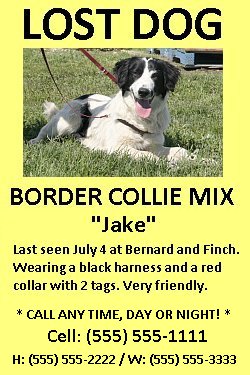 None of us ever plan to lose our pets. Sometimes, despite our best efforts,
pets go missing. Knowing where to
start looking for help can speed up the happy reunion.
None of us ever plan to lose our pets. Sometimes, despite our best efforts,
pets go missing. Knowing where to
start looking for help can speed up the happy reunion.
Catching people's attention can be hard. Everyone is so busy that you generally only have just a few precious seconds to capture their interest. Here are a few ways you can make your flyer or poster more visible:

- Use bright, fluorescent paper - white paper often goes unnoticed since it gets lost in the sea of white signs.
- Print in heavy black font (if you're handwriting it, use thick, permanent black marker - don't use water-soluble marker). Thin fonts are too difficult to read at a glance, and won't be easily visible from a distance. Choose a font that's easy to read (no script fonts).
- Use big letters to convey the most important information. Keep it short as possible, around 5 words or fewer if you can. Don't use 'filler' words like 'Please' or 'Thank you' in this large text -- it just takes up valuable space.
- Keep the description brief: date and location where your pet was last seen, colour of the collar, your pet's breed & colour, a short description of your pet's temperament (shy, friendly, fearful, etc). Don't include the identification or license tag numbers, or your pet's unique identifying marks; these are things you can use to see if callers really have your pet.
- Use a good-quality, close-up photo of your pet. Make sure it's large enough on the flyer so that people can see him clearly.
- Print in colour - your pet's photo will display better this way.
- List your phone number(s) clearly, and let people know that if it's okay to call any time. Consider forwarding your home phone to your cell phone so that you can be sure you get any messages promptly.
- Use plastic sheet protectors to shield the flyers from rain or weather damage. Fold down the top of the protector and securely tape it shut.
Put up signs around the neighbourhood and the areas you normally frequent with your pet. Respectfully ask local shop owners, gas stations, schools, etc. if they would allow you to put up a poster.Post on pet recovery sites (like PetLynx) and on online classified ad pages, wherever available.
Get your signs up fast to reach as many people as possible, as soon as possible.
Bring along a stack of flyers (with your pet's photo) that you can give away to people. Ask neighbours if they've seen your pet and to spread the word. Leave extra flyers with people who are willing to give them away. Go to where you normally walk your dog, and ask other dog walkers to keep an eye out for your pet. The simple act of asking someone for help (politely!) can make a world of difference, rather than passively sitting back and stapling a flyer to a telephone pole.Give any delivery people (letter carriers, FedEx, etc) a copy of your flyer. They go all over the city and just might spot your pet.
Shelter staff are usually very busy and may not always know all of the incoming pets or the descriptions may be too vague. Even if they say there is no animal there that fits your pet's description, go there anyways. Then you'll be able to see for yourself.Ask the shelter if there are other places you should check. Many municipalities have both a humane society as well as a municipal pound. Ask if you can leave them a few copies of your flyer.
Facebook and Twitter are the most popular and well-known social media sites. Getting the word out via social media has miraculously brought home many pets!On Facebook, search for pet-related pages, local pages, pet lost & found groups, and pet rescue and humane societies in your local area. Post a photo of your pet, the date/time/place they were lost, a description, and your phone number(s). Do not post your pet's unique markings; you want to keep this to yourself to make sure anyone responding really does have your pet. Always be sure to post the city or town, province or state, that your pet was lost - many times people forget to do this and it just results in confusion and lost time. Ask people to share the post.
On Twitter, tag local rescue groups and humane societies, lost & found groups, and other pet groups or personalities known to be friendly towards this type of thing. Include a photo with your pet's name and your contact information right on the photo. Ask people to re-tweet.
Asking for a 'share' or a 're-tweet' is important - it can spur on people who wouldn't otherwise do so, and the more attention your post or tweet gets, the better the odds become of someone, somewhere, possibly spotting your pet.
There are things you can do to help prevent a lost pet... and things you can do to be prepared just in case your pet goes missing. Put together a 'pet ID' kit for each of your pets that includes the following information:
- A minimum of one clear, close-up, recent photo. Ideally, the kit would include a few photos - a full-body photo (standing beside something to give an idea of the size of your pet is good), a close-up of your pet's face, and photos of any unique identifying marks.
- Records of your pet's identification numbers:
- Tattoo number and location (eg. right ear, left thigh);
- Municipal license tag number and the name of the municipality;
- Microchip number;
- Any additional ID your pet may be wearing.
- A detailed description of any unique identifying marks on your pet, including the location of the mark. For example: dime-sized bald patch on the underside of the chin on the right side; or 2" white patch near the base of the tail.
- General description: approximate height and weight, colour(s), short/medium/long fur, erect/semi-erect/floppy ears, etc. Include information on the type and colour of the collar / harness / leash your pet is wearing (even though we see these things every day, it can be difficult to remember in a stressful situation so write it down).
Accidents can happen to even the most responsible pet owner. Don't lose hope if your pet goes missing ... get the word out there and keep looking - happy reunions happen all the time.
"Great friends are hard to find, difficult to leave, and impossible to forget." (Author Unknown)
Comments (0)